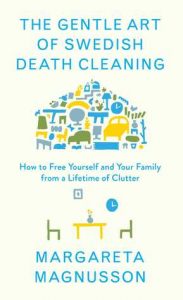Before we get to the books, beloved patrons, we wanted to let you know about a very special event taking place at our West Branch next week.
As some of you may know, the West Branch Children’s Librarian of Dale Sampson will be retiring on April 4. Miss Dale has been a true treasure for the library for twenty-nine years, and while we will miss her enormously, we are also so happy to see her begin a new chapter in her adventures! To that end, the West Branch will be hosting an Open House on Tuesday, April 2, from 3:00pm – 6:00pm to give all of Miss Dale’s patrons a chance to wish her well and thank her for all she has done for the Library, for Peabody, and for all the readers whose lives she has touched. Please help us send her off in style with well wishes, some refreshments and lots of good cheer!
And now, on to the books!

Oksana, Behave!: A delightful coming-of-age novel, an immigrant story, and a moving historical narrative all rolled into one, Maria Kuznetsova’s fiction debut is a vibrant treat on every level. When Oksana’s family begins their new American life in Florida after emigrating from Ukraine, her physicist father delivers pizza at night to make ends meet, her depressed mother sits home all day worrying, and her flamboyant grandmother relishes the attention she gets when she walks Oksana to school, not realizing that the street they’re walking down is known as Prostitute Street. Oksana just wants to have friends and lead a normal life—and though she constantly tries to do the right thing, she keeps getting herself in trouble. As she grows up, she continues to misbehave, from somewhat accidentally maiming the school bus bully, to stealing the much-coveted (and expensive-to-replace) key to New York City’s Gramercy Park, to falling in love with a married man. As her grandmother moves back to Ukraine, her father gets a job at Goldman Sachs, and her mother knits endless scarves, Oksana longs for a Russia that looms large in her imagination but is a country she never really knew. When she visits her grandmother in Yalta and learns about Baba’s wartime past and her lost loves, Oksana begins to see just how much alike they are, and comes to a new understanding of how to embrace life and love without causing harm to the people dearest to her. But will Oksana ever quite learn to behave? Critics and readers have been lining up to praise this comic saga, with Publisher’s Weekly cheering, “Kuznetsova’s standout debut offers a fresh and funny look into the life of a bold young immigrant woman. . . . This accomplished and frank work is a new take on an immigrant girl’s complicated coming-of-age.”
A Bound Woman is a Dangerous Thing: The Incarceration of African American Women from Harriet Tubman to Sandra Bland: For black American women, the experience of being bound has taken many forms: from the bondage of slavery to the Reconstruction-era criminalization of women; from the brutal constraints of Jim Crow to our own era’s prison industrial complex, where between 1980 and 2014, the number of incarcerated women increased by 700% (according to The Sentencing Project). For those women who lived and died resisting the dehumanization of confinement–physical, social, intellectual–the threat of being bound was real, constant, and lethal. Yet Black women freedom fighters have braved violence, scorn, despair, and isolation in order to lodge their protests throughout the course of American history, and in this stirring and enlightening work, DaMaris Hill honors their experiences with harrowing yet hopeful poetic responses to her heroes, from Zora Neale Hurston, Lucille Clifton, Fannie Lou Hamer, Grace Jones, to Eartha Kitt, and others. This is a work that celebrate the modern-day inheritors of their load and light, binding history, author, and reader in an essential legacy of struggle. Booklist gave this powerful collection a starred review, and named it one of their Top Ten Diverse Nonfiction Titles, noting how “In this distinctive inquiry in verse, Hill reflects on black women who resisted violent racism and misogyny, ranging from the notable and notorious to the lesser-known yet no less heroic.”
Gingerbread: How many fairy tales and children’s books can you remember that feature gingerbread? More than one, I’m willing to bet. Inspired by this oddly ubiquitous food, Helen Oyeyemi has crafted an enchanting tale of family legacies and recipes. Perdita Lee may appear to be your average British schoolgirl; Harriet Lee may seem just a working mother trying to penetrate the school social hierarchy; but there are signs that they might not be as normal as they think they are. For one thing, they share a gold-painted, seventh-floor walk-up apartment with some surprisingly verbal vegetation. And then there’s the gingerbread they make. Londoners may find themselves able to take or leave it, but it’s very popular in Druhástrana, the far-away (or, according to many sources, non-existent) land of Harriet Lee’s early youth. The world’s truest lover of the Lee family gingerbread, however, is Harriet’s charismatic childhood friend Gretel Kercheval —a figure who seems to have had a hand in everything (good or bad) that has happened to Harriet since they met. Decades later, when teenaged Perdita sets out to find her mother’s long-lost friend, it prompts a new telling of Harriet’s story. As the book follows the Lees through encounters with jealousy, ambition, family grudges, work, wealth, and real estate, gingerbread seems to be the one thing that reliably holds a constant value. Oyeyemi is a marvelous storyteller, and her books always dance on the line between reality and fantasy in a marvelously unique manner. The New York Times Review of Books agrees, calling this novel “Exhilarating. . .Gingerbread is jarring, funny, surprising, unsettling, disorienting and rewarding. . .This is a wildly imagined, head-spinning, deeply intelligent novel that requires some effort and attention from its reader. And that is just one of its many pleasures.”
Make Me A City: Another unique blend of history and fiction, Jonathan Carr’s novel brings us to the city of Chicago in the 19th century, and shows how the greatest of moments can come from the smallest of events. The tale begins with a game of chess—and on the outcome of that game hinges the destiny of a great city. From appalling injustice springs forth the story of Chicago, and the men and women whose resilience, avarice, and altruism combine to generate a moment of unprecedented civic energy. A variety of irresistible voices deliver the many strands of this novel: those of Jean Baptiste Pointe de Sable, the long-unheralded founder of Chicago; John Stephen Wright, bombastic speculator and booster; and Antje Hunter, the first woman to report for the Chicago Tribune. The stories of loggers, miners, engineers, and educators teem around them and each claim the narrative in turns, sharing their grief as well as their delight. As the characters, and their ancestors, meet and part, as their possessions pass from hand to hand, the reader realizes that Jonathan Carr commands a grand picture, one that encompasses the heartaches of everyday lives as well as the overarching ideals of what a city and a society can and should be. With it’s multi-layered narratives and rich characters, this is another debut novel that is earning praise. Kirkus Reviews delighted in the ways that “The rise of Chicago in the 19th century provides the frame for a trove of colorful stories and characters in this entertaining debut novel.”
The Woman in the Dark: It’s so refreshing to have a woman in the title of a thriller (instead of another Girl). In any event, Vanessa Savage’s heady psychological thriller brings all the delightful darkness of the gothic tradition into the present day. Sarah and Patrick are happy. But after her mother’s death, Sarah spirals into depression and overdoses on sleeping pills. While Sarah claims it was an accident, her teenage children aren’t so sure. Patrick decides they all need a fresh start and he knows just the place, since the idyllic family home where he was raised has recently come up for sale. There’s only one catch: for the past fifteen years, it has become infamous as the “Murder House”, standing empty after a family was stabbed to death within its walls. Patrick believes they can bring the house back to its former glory, so Sarah, uprooted from everything she knows, pours her energy into painting, gardening, and giving the rotting old structure the warmth of home. But with locals hinting that the house is haunted, the news that the murderer has been paroled, strange writing on the walls, and creepy “gifts” arriving on the doorstep at odd hours, Sarah can’t shake the feeling that something just isn’t right. Not with the house, not with the town, or even with her own, loving husband — whose stories about his perfect childhood suddenly aren’t adding up. Can Sarah uncover the secrets of the Murder House before another family is destroyed? Find out in this twisty treat that Good Housekeeping called “‘Claustrophobic and compelling.”
Until next week, Beloved Patrons–happy reading!








 The Wellcome Institute was originally funded by Sir
The Wellcome Institute was originally funded by Sir 

 Murmur by Will Eaves: Please note, this title will be released April 9, 2019. In this intense, hallucinatory story, Will Eaves, a celebrated poet, brings us into the brilliant mind of Alec Pryor, a character inspired by Alan Turing. Turing, father of artificial intelligence and pioneer of radical new techniques to break the Nazi Enigma cipher during World War II, was later persecuted by the British state for “gross indecency with another male” and forced to undergo chemical castration. This novel unfolds in the weeks leading up to Turning/Pryor’s suicide, and offers a glimpse into not only the life of one remarkable human being, but into the very nature of consciousness, as well as an unflinching look at the systems of prejudice and privilege that seek to limit human expression in all its forms.
Murmur by Will Eaves: Please note, this title will be released April 9, 2019. In this intense, hallucinatory story, Will Eaves, a celebrated poet, brings us into the brilliant mind of Alec Pryor, a character inspired by Alan Turing. Turing, father of artificial intelligence and pioneer of radical new techniques to break the Nazi Enigma cipher during World War II, was later persecuted by the British state for “gross indecency with another male” and forced to undergo chemical castration. This novel unfolds in the weeks leading up to Turning/Pryor’s suicide, and offers a glimpse into not only the life of one remarkable human being, but into the very nature of consciousness, as well as an unflinching look at the systems of prejudice and privilege that seek to limit human expression in all its forms. Mind on Fire: A Memoir of Madness and Recovery
Mind on Fire: A Memoir of Madness and Recovery